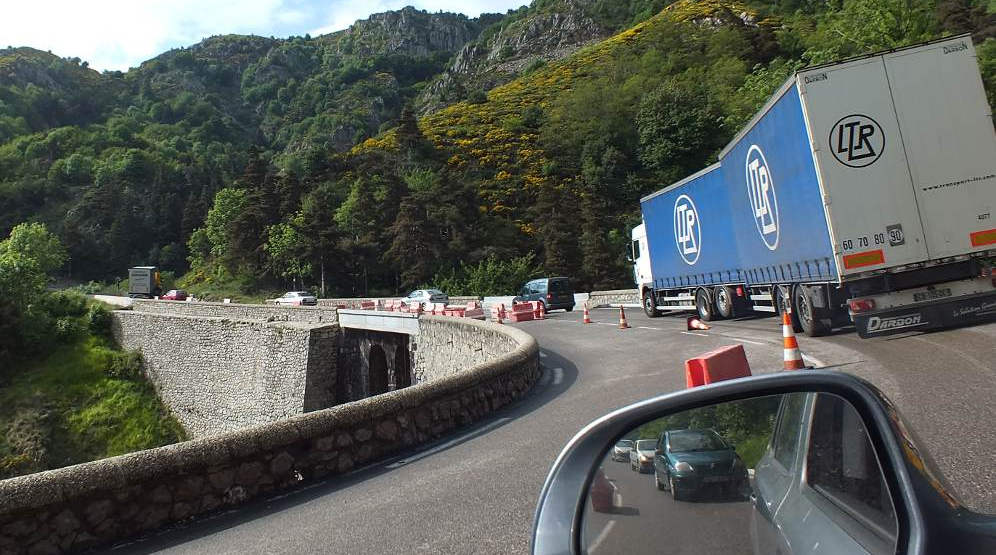
Highway rules for France
Everything you need to know before taking to the road in France.
- Explore France ►
- Visiting Paris
- Stay and get round in Paris
- France beyond Paris
- More useful pages
About-France.com - the connoisseur's guide to France
Legal requirements for driving in France
Jump
to ► Driving in France : tips and
information
Who can drive in France ?
Find
hotels
in France

Click
for best
Booking.com rates at hotels near the following towns on main motorway routes.
Calais
Reims
Dijon
Beaune
Lyon
Rouen
Orleans
Tours
Limoges
Poitiers
Bordeaux Clermont-Fd.
To drive in France, you must be in possession of a valid driving
license, and - unless you have a French provisional license for
accompanied driving - you must be at least 18 years of age. 
Reims
Dijon
Beaune
Lyon
Rouen
Orleans
Tours
Limoges
Poitiers
Bordeaux Clermont-Fd.
Book
now, pay on the day.
With Booking.com most bookings will not be charged until the time of
your stayUK and EU citizens
European Union and EEA driving licences are valid in France, so if you are from the UK, Ireland, the Netherlands, Poland or another EU or EEA country, your national license is sufficient.US, Australia and rest of world
Short-term visitors (up to 90 days) from non-EU countries, including the USA, Australia and Canada, may drive in France with their national licence, but in theory they must also have an International Driver's Permit (IDP) or "notarized" (officially certified) translation of their drivers license before coming. The IDP is obligatory in some other European countries, and car hire companies may require one.-
Foreign students
Students studying in France for the duration of their student visa must have a valid national license PLUS either an official translation into French or an IDP (International Drivers Permit)), which can be obtained ► here.
For other requirements, see Driver's checklist for France
► ► Driving rules & laws in France:
1. ► ► PHONING AT THE WHEEL BEWARE.... EVEN CERTAIN HANDS FREE mobile-phone use is banned in France. The rule applies to all hands-free phones using a headset, bluetooth or wired. Drivers caught using a mobile phone while on the road in France are liable to an on-the-spot fine of 135 Euros – and 3 penalty points if they have a French driving licence, and immediate suspension of their licence (regardless of nationality). Statistics show that phoning at the wheel increases the risk of accident by a factor of three. The only type of mobile phone now legal to use in France while driving is one that is entirely hands-free and headphone free.
2. ► ►SPEED CAMERAS IN FRANCE
 There
are now in France over 150 unmarked police vehicles equipped with
onboard speed cameras. Most of these - but not all
nor always
- patrol on motorways, or other trunk routes, but they are now
operating throughout France, on minor roads too. Since recording speed
from a moving vehicle is not quite a perfect art, there is a
slight tolerance; but vehicles clocked at over 140 Km/h in a
130 stretch of motorway are liable to get pulled a ticket and may be
pulled over for an on-the-spot
fine.
There
are now in France over 150 unmarked police vehicles equipped with
onboard speed cameras. Most of these - but not all
nor always
- patrol on motorways, or other trunk routes, but they are now
operating throughout France, on minor roads too. Since recording speed
from a moving vehicle is not quite a perfect art, there is a
slight tolerance; but vehicles clocked at over 140 Km/h in a
130 stretch of motorway are liable to get pulled a ticket and may be
pulled over for an on-the-spot
fine. Most of the cameras are on board unmarked Renault Mégane, Citroën Berlingo or Peugeot 208 police cars, so they are not easy to detect - apart from the fact that the cars tend to be very clean, specially the windows. However, drivers are unlikely to notice one until it's too late, if they notice them at all. Thanks to new technology, these new speed camera cars can even flash vehicles going in the opposite direction .
NEW Police have recently acquired a lot of mobile speed camera units, which can be parked at the roadside in any suitable place, and with no warning. Some roads may show signs saying something like "Speed cameras for the next 50 km"... which is liable to mean that they use a mobile camera on that particular stretch. The mobile cameras are small white trailers seemingly abandoned at the roadside.
Beware also of average speed cameras, which record your speed between two points, often several kilometres apart. These are increasingly showing up on normal main roads, and they are not always indicated in advance. When they are indicated, it is just with the normal speed camera warning sign. So be warned! Observe speed limits, and you won't have any problems !
Also see Speed cameras below
3. ► ► French Breathalyzer law
Carrying a brethalyzer with you in the car is a legal requirement in France... - at least in theory. BUT this is a wonderful law that you are free to observe or not observe, as there is no penalty for drivers caught without a brethalyzer in their car.Single-use certified breathalyzers are now available in many supermarkets, chemists and garages throughout France, at a cost of about 1 €uro each. So the cost is minimal.
Contrary to information posted on some sites, the new law (Decree no 2012-284) does not oblige drivers to self-test after having a drink. But those who plan to self-test to be on the safe side should have at least two breathalyzers in the car, if not more.
To conclude - breathalyzer or not - don't drink and drive. And remember that the tolerated blood alcohol level in France is 0.5 mg. per ml - just over half the limit tolerated in England (0.8 mg per ml).
4. ► ► VEHICLE EMISSION REGULATIONS The central areas of Paris, Lyon and Grenoble, Strasbourg, Nancy, Rennes and Toulouse have adopted low emission zone regulations.
For central Paris (within the Boulevard Périphérique), restrictions apply every weekday. As from July 2019 the restrictions are extended to cover the whole area inside the A86 orbital motorway (though motorways and the périphérique are not concerned).
For other cities, notably Grenoble, Lille, Lyon, Rennes Strasbourg and Toulouse, restrictions apply only in the event of serious episodes of air pollution. Though most common in winter, these can occur at any time of year.
To be compliant with the rules, vehicles must diplay an exhaust-gas quality sticker, known as a vignette Crit'air, placing them in one out of six categories. Generally speaking, cleaner vehicles (categories 1 to 3) are not concerned by restrictions; vehicles that generate more pollution may be concerned.
Foreign-registered vehicles are not exempted and must obtain a sticker if they think they may need to be in a restricted zone on a restricted day. However vehicles not entering Paris nor visiting any of the major cities concerned on a poor air-quality day do not need to have a Crit'air sticker, and most vehicles in provincial France do not have one.
Crit'air emissions quality certificate stickers can be ordered online from the French government agency running the scheme. The cost is just 3.62 Euros + postage. Click here for more information and to order from the official site.
BEWARE.... SPEED CAMERA WARNING DEVICES These are banned in France. Drivers using radar detectors (speed camera detectors) are liable for a fine of 1500 Euros and 6 points off their licence. This applies to specific radar warning devices, such as the Coyote, which must have their software updated to remain legal.
With regard to TomToms and other GPS systems, which have speed camera locations programmed in to their software, the situation is confusing. These are not officially "radar detectors", but manufacturers are obliged to make new software available, and most have done so. Tomtoms and other GPS systems are technically in breach of the law if they still have radars listed in their Points of Interest software; and even if it is not clear how roadside police can stop and check for offending software, rather than hardware, drivers are warned to err on the side of precaution and download the latest map software for France. This is advisable anyway, since older software is not up to date with regard to new routes, new speed restrictions, and other changes.
For both existing radar warning devices and GPS devices, current radar information is being replaced with warnings to announce "danger zones", many of which will be areas with speed cameras.
►
Car hire in France.
Cars can be hired throughout France, at airports, in city centres, at mainline railway stations and other locations. The big names in car hire all have their operations in France, but there are also a number of cheaper suppliers. Visit our car-rentals page and get your quotes from a range of companies. Click for car-hire in France
Cars can be hired throughout France, at airports, in city centres, at mainline railway stations and other locations. The big names in car hire all have their operations in France, but there are also a number of cheaper suppliers. Visit our car-rentals page and get your quotes from a range of companies. Click for car-hire in France
MAIN FRENCH LAWS
► Travel documents, things you must have with you in the car when driving in France
Click to visit Before driving to France - a checklist.► Children in the car, seatbelts.
Children under 10 years old are not allowed to travel in the front seat of a car, unless there are no back seats. Children under 10 years of age must travel in the back, using an appropriate child seat or booster seat. Babies are allowed to travel in the front passenger seat, but only when placed in an approved rear-facing baby seat and the airbag is turned off.Seatbelts must be worn at all times when driving in France, by both adults and children, and both in the back and front seats. Rear passengers can only travel without seatbelts in the back of older cars in which they are not fitted (Article R412-1 of the French Highway code).
► Speed limits and other rules
Here are the normal speed limits for driving in France:- The normal speed limit on French motorways is 130 km/hr (just over 80 mph). - or 110 km/hr in rain.
- The normal speed limit on dual carriageways (divided highways) is 110 km/hr
- The normal speed limit on main roads is 80 km/hr (outside built-up areas). However while the 80 km/hr applies on all single carriageway routes nationales (N roads), paradoxically it often does not apply on good routes départementales ( D roads) where local councils have used their powers to raise the limit to 90.
- The normal speed limit in built-up areas is 50 km/hr – unless otherwise indicated.
Over the limit? Generally, there is a small tolerance for drivers who exceed the speed limit - but be advised that it is best to observe speed limits which are there for a reason. Until recently, speed cameras tended to be stationary and visible; nowadays, the gendarmerie are using more and more mobile radars, in unmarked cars. Be warned ! Otherwise you may face an on-the-spot fine or - if your are caught driving more than 50 km/hr over the limit - an instant ban and an impounding of your vehicle.
Under the limit? The minimum driving age in France is 18. Younger drivers under the age of 18 cannot drive a car in France even if they have a full driving licence from another country. In France, younger drivers can drive as learners if accompanied by a fully licensed driver, and only after they have passed the theoretical part of the French driving test.
Speed cameras
There are now well over two thousand stationary speed cameras on France's roads and motorways, so take care !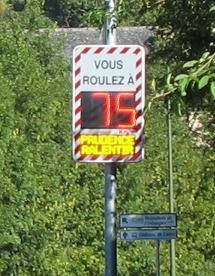 ►
Speed camera
warnings .
Some of the big old signs that used to warn drivers of an
upcoming
speed
camera have been removed. But most of those that have gone have now
been replaced by automatic
speed detectors,
which flash up
the speed of each approaching car on a luminous panel.
►
Speed camera
warnings .
Some of the big old signs that used to warn drivers of an
upcoming
speed
camera have been removed. But most of those that have gone have now
been replaced by automatic
speed detectors,
which flash up
the speed of each approaching car on a luminous panel. It's best to understand what these are about: if you see a luminous panel flashing up, say 101 then 99, then 97 as you approach it while decelerating, that is your speed. The photo, right, is flashing a red 75, because the car approaching is exceeding the 70 Km/h speed limit in the location. So keep down or drop down to below the speed limit, as there is quite likely to be - though not always - a speed camera coming up. Some speed detectors just flash up your speed in white lights, others in green or red lights depending on whether you are within or above the speed limit. Some show a smiley below the speed - grumpy if you're above the limit, smiling if you're within the limit.
Most fixed speed cameras now have warnings of some sort or another. This goes for static cameras and for the new average speed cameras. But obviously, it does not go for mobile cameras carried round and set up by gendarmes. The only warning you may get of these is when approaching cars flash their headlights at you.
New radars are being set up all the time, so any unofficial maps that may be available on the Internet are unlikely to be complete, and in any case cannot include the mobile radar cars or the movable stationary speed cameras, of which there are currently about 1000. So the best rule - not to say the most sensible one - is "Do not exceed the speed limit".
Average speed cameras - "radars tronçon" : The first average speed cameras, known in French as radars tronçon, were introduced on French roads and motorways in 2012. These cameras, already used in several other countries, calculate the average speed of a vehicle driving between two points. Their use is being developed, and there is no specific warning saying "Average speed cameras in use" nor even the equivalent in French. You just need to be aware that posts at the side of a road carrying a couple of cameras or more are liable to be average speed cameras.
Contrary to a sometimes-heard myth, toll tickets are not knowingly used to compute a car's average speed between two points.
Mobile phones: it is an offence to hold and use a mobile phone while driving in France. Hands-free use of mobile phones is not illegal. Though many drivers ignore this rule, traffic police are clamping down on drivers holding phones to their ears while driving, and drivers are liable to an on-the-spot fine.
Minimum age: The minimum age for driving a car in France is 18; thus no-one under the age of 18 can drive a car in France, even if he or she holds a valid licence in another country.
"Priorité à droite" - Priority to the right.
This is a historic French driving rule which remains valid to this day at any intersection where priority is not indicated.Once upon a time, this was the general rule in France; at any intersection, traffic had to give way to cars coming in from the right. Today this is still true only on very minor rural roads, and at junctions in towns, suburbs and villages, between roads of similar status, when there are no signs indicating which road has priority.
All main roads - N roads and D roads - are generally priority roads, marked with a yellow diamond sign. Priority ends when there is a yellow diamond with a black strike-through. While on a priority road, you have priority over all traffic coming in from a side road, unless your priority ends.
Priority may end at the entrance to an urban road system, or at a roundabout. It must be signaled.
When not on a priority road, for instance on a small rural road, you must give way to traffic coming in from the right, unless the road on the right has a stop or give-way sign.
Roundabouts: in 99.9% of cases, priority is indicated. Traffic already on a roundabout has priority over traffic entering it.... so no priority to the right here. EXCEPT at some big urban roundabouts such as the place de l'Etoile on the Champs Elysées in Paris, where it is priority to traffic entering, or trying to enter, the roundabout system.
Wining and driving
Wine is available with meals in French motorway service areas - a fact that surprises a lot of visitors. But don't forget that the drink drive limit in France is lower than it is in the UK. The best advice is the same everywhere; don't drink and drive.
► Road accident and breakdown information
Drivers taking their car abroad are strongly advised to have some form of breakdown cover that will ensure repatriation of the vehicle in the event of problem or immobilisation.1. Avoiding accidents
Driving in Bad weather conditions
 Heavy July
rainstorm on a French motorway
Heavy July
rainstorm on a French motorway
Turn on your headlights whenever driving in rainy conditions, specially on motorways and main roads. In very heavy rain conditions, when there is lots of road spray, use fog-lights and in particular rear fog-lights, if you have them. This is not a legal obligation, it is just plain common sense. Leave a greater distance than usual between you and the vehicle in front.
In the most torrential downpour conditions, put on your emergency warning lights, pull onto the hard shoulder, or completely off the carriageway, and stop until it is safe to proceed.
Fog is uncommon in summer, but can be encountered in mountain areas. Put on headlights, and fog lights if you have them, Reduce your speed, and proceed with caution.
2. What to do in the event of a road accident in France
If you are involved in any accident involving two or more vehicles while driving in France, you will be asked to fill in a "constat amiable" (an amiable declaration) by the driver of a French car involved. This is standard practice.
If possible, call your insurance company at once on your mobile phone. They may put you in touch with a local French representative. If your vehicle is badly damaged or immobilized, and you have some other form of special continental vehicle assistance and repatriation service, phone them first.
If you are involved in an accident involving any sort of injury - even if it is not your fault - you MUST remain until the police have come. This is a legal requirement.
Click this link for further information about doctors, hospitals and using the French health service.
Hazard warning triangle
Breakdown or accident: if your car is immobilised on, or partly on, the road due to a breakdown or an accident, you must set up your red warning triangle at a suitable distance behind the vehicle, to alert approaching traffic to the hazard. All cars driving in France must by law carry a red warning triangle, available from any motoring store, and also a yellow fluorescent jacket.Stop to shop...
See the French shopping guide page for useful information if you are planning to stop to shop on your way back home...
Driving in France - Route maps
► South from Calais -best routes to the south of France
► Real time map showing traffic congestion and hazards on French roads. Zoom in.
► French motorways mapRoute
maps showing hotels
►S & SW: routes via Rouen - E5, E9, E11
► Southwest : A10 Paris-Bordeaux - E5
►Southeast : A26 via Reims - E17, E15
►East - West : E19 - E44 from Belgium
► North - south Routes from Cherbourg interactive map
Routes avoiding
tolls:
Options using minimal tolls,► to SW France and N Spain
► to the Alps and the Mediterranean ► Driving in Spain
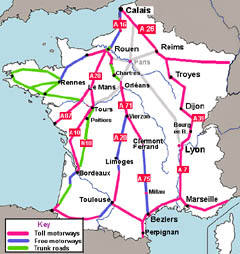
By car through France - the main routes for driving to the south or west of France: ► click map for enlargement and details.
► ► Don't fall for the "cheap ferries" scam
Some internet sites that announce "cheap" ferry prices are actually charging more than the Ferry companies themselves. When taking a car to France, avoid dodgy websites by booking directly with ferry companiesAbout-France.com
- over 300 pages of up-to-date general, cultural, travel and tourist
information about France, written by people who know. All content on
this site is written exclusively for this website .
An
independent website, About-France.com is an affiliate partner of a
selection of other relevant websites websites,
and may receive a small commission on sales generated after users click
through to a partner site.
Click here for
low-cost car hire in France
low-cost car hire in France
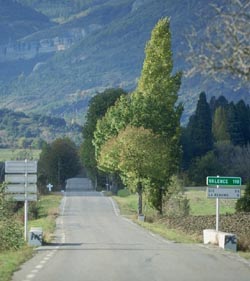
Quiet country roads....
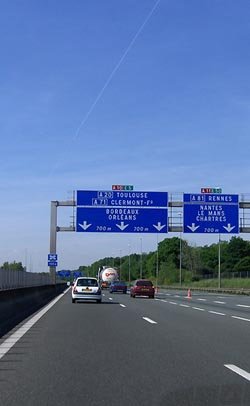
Motorway driving in France is normally quite relaxed...
Related pages:
Public
holidays in France.
The following days are public holidays ("jours fériés") in France, when all or most shops tend to be shut.
Note that on public holidays, hypermarkets will generally be shut, so unless you have a chip and pin credit card that works in French automatic petrol pumps, you'll need to fill up on the motorway or in normal filling stations.
The following days are public holidays ("jours fériés") in France, when all or most shops tend to be shut.
- January 1st, New year's day
- Easter Monday (though not Good Friday except in Alsace),
- May 1st, Labour Day, Fête du Travail
- May 8th, Armistice Day
- Ascension Thursday
- July 14th, Bastille Day, Fête Nationale
- August 15th, French August bank holiday
- November 1st, Toussaint, All Saints' Day
- November 11th, Armistice, first world war.
- Christmas (though not Boxing Day)
Note that on public holidays, hypermarkets will generally be shut, so unless you have a chip and pin credit card that works in French automatic petrol pumps, you'll need to fill up on the motorway or in normal filling stations.
Other
"driving in" pages....
You may also like....
You may also like....
- Driving in Spain
- Driving in Britain for foreign visitors
- Driving in Quebec (and Canada)
Photo above: Joe Schlabotnik
Licence CC.
Website text and photos © copyright About-France.com unless otherwise stated
